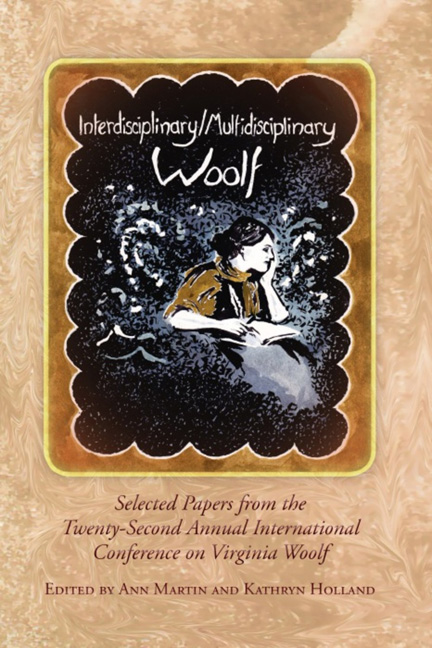Book contents
- Frontmatter
- Contents
- Introduction to Interdisciplinary/Multidisciplinary Woolf
- Acknowledgments
- List of Abbreviations
- History, Materiality, Multiplicity
- Patterns, Practices, Principles
- Art, Influence, Embodiment
- “Time has whizzed back an inch or two on its reel”: Relating Virginia Woolf and Emily Carr through Vintage Postcards, Lily Broscoe, Mrs. McNab, and the Cinematic Time of To the Lighthouse
- Speaking Citizen to Citizen in a Time of War: Miss La Trobe's Use of Parabasis in her Historical Pageant
- Work as Salvation: Eureka's Angel in the House, A Dircetor's Experience
- Drawing as Thinking: A Visual Response to To the Lighthouse
- Performing Feminism, Transmitting Affect: Isadora Duncan, Virginia Woolf, and the Politics of Movement
- Virginia Woolf and Clarice Lispector: Thinking Back Through Brazilian Mothers
- Mystical Gibberish or Renegade Discourse?: Poetic Language According to Orlando
- Selves and Others as Narrative Participants in Woolf's Novels
- Publishing, Politics, Publics
- Notes on Contributors
- Conference Program
Selves and Others as Narrative Participants in Woolf's Novels
from Art, Influence, Embodiment
- Frontmatter
- Contents
- Introduction to Interdisciplinary/Multidisciplinary Woolf
- Acknowledgments
- List of Abbreviations
- History, Materiality, Multiplicity
- Patterns, Practices, Principles
- Art, Influence, Embodiment
- “Time has whizzed back an inch or two on its reel”: Relating Virginia Woolf and Emily Carr through Vintage Postcards, Lily Broscoe, Mrs. McNab, and the Cinematic Time of To the Lighthouse
- Speaking Citizen to Citizen in a Time of War: Miss La Trobe's Use of Parabasis in her Historical Pageant
- Work as Salvation: Eureka's Angel in the House, A Dircetor's Experience
- Drawing as Thinking: A Visual Response to To the Lighthouse
- Performing Feminism, Transmitting Affect: Isadora Duncan, Virginia Woolf, and the Politics of Movement
- Virginia Woolf and Clarice Lispector: Thinking Back Through Brazilian Mothers
- Mystical Gibberish or Renegade Discourse?: Poetic Language According to Orlando
- Selves and Others as Narrative Participants in Woolf's Novels
- Publishing, Politics, Publics
- Notes on Contributors
- Conference Program
Summary
As they interpret a text, readers of most narratives must differentiate among multiple viewpoints, punctuated perhaps by quotation marks or indicated through shifts in focalization. Woolf is well known for conveying multiple perspectives in her work, often even in a single sentence, but she presents an extra challenge because her characters also express multiple selves and relationships with each other. Orlando's biographer, for example, suggests she “may as well have [six or seven] thousand” selves, and Orlando variously refers to her lover at the end of the novel as Mar, Shelmerdine, or Bonthrop (or “all three together”), meaning for each name a different man and a different self who calls him (213). This complexity requires a more nuanced approach to character and viewpoint than traditional narratology has provided us, for two reasons. First, Woolf's characters multiply under scrutiny, such that referring to them by name is ambiguous (which Orlando?). Second, they construe themselves intersubjectively—differently depending on the presence or absence of others—so that it is difficult to tell where one character ends and another begins. To what do Woolf's characters refer when they invoke these selves or particular versions of others, and how do readers resolve multiple construals into a single ‘character’? To answer these questions, we require a robust methodology sensitive to intersubjective relationships and capable of operating for characters within the text as well as for readers without. As I hope to demonstrate, a cognitive approach to narrative satisfies these requirements. After introducing the discipline and defining subject and self as metaphorical constructs, I turn to passages from To the Lighthouse and The Waves to show how Woolf's characters conceptualize their selves and others in similar ways: her subjects construe self and other as participants in an ongoing narrative as they interpret the world around them. Woolf's use of multiple construals is a crucial narrative strategy in her pursuit to depict life as accurately as possible. Moreover, that these construals are active participants in the minds of their characters supports the theory that narrative is an integral aspect of cognition.
Cognitive narratology is informed in part by cognitive grammar, an approach to language that focuses on the conceptualization of grammar and the importance of embodiment in language acquisition and use.
- Type
- Chapter
- Information
- Interdisciplinary/Multidisciplinary Woolf , pp. 201 - 206Publisher: Liverpool University PressPrint publication year: 2013



